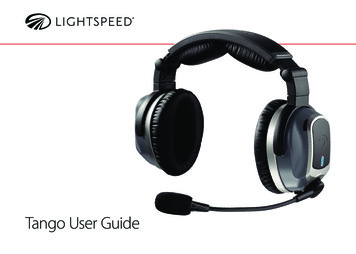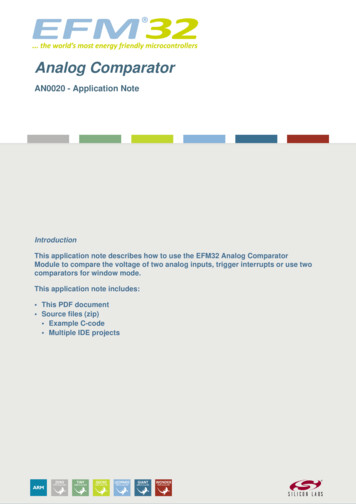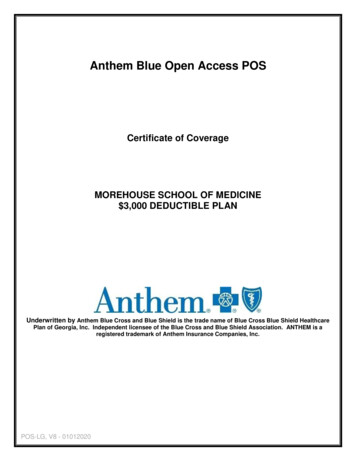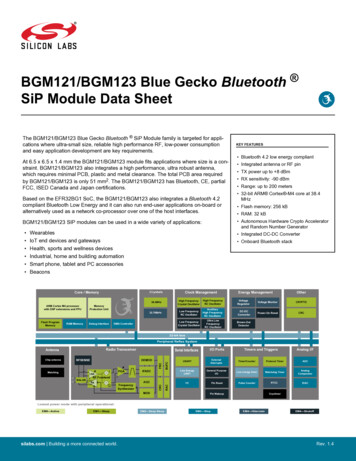
Transcription
BGM121/BGM123 Blue Gecko Bluetooth SiP Module Data SheetThe BGM121/BGM123 Blue Gecko Bluetooth SiP Module family is targeted for applications where ultra-small size, reliable high performance RF, low-power consumptionand easy application development are key requirements.At 6.5 x 6.5 x 1.4 mm the BGM121/BGM123 module fits applications where size is a constraint. BGM121/BGM123 also integrates a high performance, ultra robust antenna,which requires minimal PCB, plastic and metal clearance. The total PCB area requiredby BGM121/BGM123 is only 51 mm2. The BGM121/BGM123 has Bluetooth, CE, partialFCC, ISED Canada and Japan certifications.KEY FEATURES Bluetooth 4.2 low energy compliant Integrated antenna or RF pin TX power up to 8 dBm RX sensitivity: -90 dBm Range: up to 200 meters 32-bit ARM Cortex -M4 core at 38.4MHzBased on the EFR32BG1 SoC, the BGM121/BGM123 also integrates a Bluetooth 4.2compliant Bluetooth Low Energy and it can also run end-user applications on-board oralternatively used as a network co-processor over one of the host interfaces. Flash memory: 256 kBBGM121/BGM123 SIP modules can be used in a wide variety of applications: Autonomous Hardware Crypto Acceleratorand Random Number Generator WearablesIoT end devices and gatewaysHealth, sports and wellness devicesIndustrial, home and building automationSmart phone, tablet and PC accessoriesBeaconsCore / Memory Integrated DC-DC Converter Onboard Bluetooth stackClock ManagementCrystals38.4MHzARM Cortex M4 processorwith DSP extensions and FPUMemoryProtection Unit32.768kHzFlash ProgramMemoryRAM MemoryDebug Interface RAM: 32 kBDMA ControllerEnergy ManagementOtherHigh FrequencyCrystal OscillatorHigh FrequencyRC OscillatorVoltageRegulatorVoltage MonitorCRYPTOLow FrequencyRC OscillatorAuxiliaryHigh FrequencyRC OscillatorDC-DCConverterPower-On ResetCRCLow FrequencyCrystal OscillatorUltra LowFrequencyRC OscillatorBrown-OutDetector32-bit busPeripheral Reflex SystemRFSENSEFRCDEMODLNABALUNIPGAIFADCI/O PortsTimers and TriggersAnalog I/FUSARTExternalInterruptsTimer/CounterProtocol TimerADCLow EnergyUARTGeneral PurposeI/OLow energy timerWatchdog TimerAnalogComparatorI2CPin ResetPulse CounterRTCCIDACRF l InterfacesMODRACChip antennaBUFCRadio TransceiverAntennaCryotimerPin WakeupLowest power mode with peripheral operational:EM0—ActiveEM1—Sleepsilabs.com Building a more connected world.EM2—Deep SleepEM3—StopEM4—HibernateEM4—ShutoffRev. 1.4
BGM121/BGM123 Blue Gecko Bluetooth SiP Module Data SheetFeature List1. Feature ListThe BGM121/BGM123 highlighted features are listed below. Low Power Wireless System-on-Chip. High Performance 32-bit 38.4 MHz ARM Cortex -M4 withDSP instruction and floating-point unit for efficient signalprocessing 256 kB flash program memory 32 kB RAM data memory 2.4 GHz radio operation TX power up to 8 dBm Low Energy Consumption 8.7 mA RX current at 2.4 GHz 8.2 mA TX current @ 0 dBm output power at 2.4 GHz 63 μA/MHz in Active Mode (EM0) 2.5 μA EM2 DeepSleep current (full RAM retention andRTCC running from LFXO) 2.1 μA EM3 Stop current (State/RAM retention) High Receiver Performance -90 dBm sensitivity @ 1 Mbit/s GFSK (2.4 GHz) Supported Protocols Bluetooth Low Energy Support for Internet Security General Purpose CRC Random Number Generator Hardware Cryptographic Acceleration for AES 128/256,SHA-1, SHA-2 (SHA-224 and SHA-256) and ECCsilabs.com Building a more connected world. Wide Selection of MCU peripherals 12-bit 1 Msps SAR Analog to Digital Converter (ADC) 2 Analog Comparator (ACMP) Digital to Analog Current Converter (IDAC) 32 pins connected to analog channels (APORT) shared between Analog Comparators, ADC, and IDAC 30 General Purpose I/O pins with output state retention andasynchronous interrupts 8 Channel DMA Controller 12 Channel Peripheral Reflex System (PRS) 2 16-bit Timer/Counter 3 4 Compare/Capture/PWM channels 32-bit Real Time Counter and Calendar 16-bit Low Energy Timer for waveform generation 32-bit Ultra Low Energy Timer/Counter for periodic wake-upfrom any Energy Mode 16-bit Pulse Counter with asynchronous operation Watchdog Timer with dedicated RC oscillator @ 50 nA 2 Universal Synchronous/Asynchronous Receiver/Transmitter (UART/SPI/SmartCard (ISO 7816)/IrDA/I2S) Low Energy UART (LEUART ) I2C interface with SMBus support and address recognitionin EM3 Stop Wide Operating Range 1.85 V to 3.8 V single power supply 2.4 V to 3.8 V when using DC-DC Integrated DC-DC -40 C to 85 C Dimensions 6.5 x 6.5 x 1.4 mmRev. 1.4 2
BGM121/BGM123 Blue Gecko Bluetooth SiP Module Data SheetOrdering Information2. Ordering InformationTable 2.1. Ordering InformationOrdering CodeProtocol StackFrequencyBandMax TXPower(dBm)BGM123A256V2RBluetooth Low Energy2.4 GHz 2BGM123A256V2Bluetooth Low Energy2.4 GHzBGM123N256V2RBluetooth Low geBuilt-in25632301000 pcsreel 2Built-in2563230260 pcstray2.4 GHz 2RF pin25632301000 pcsreelBluetooth Low Energy2.4 GHz 2RF pin2563230260 pcstrayBGM121A256V2RBluetooth Low Energy2.4 GHz 8Built-in25632301000 pcsreelBGM121A256V2Bluetooth Low Energy2.4 GHz 8Built-in2563230260 pcstrayBGM121N256V2RBluetooth Low Energy2.4 GHz 8RF pin25632301000 pcsreelBGM121N256V2Bluetooth Low Energy2.4 GHz 8RF pin2563230260 pcstraySLWSTK6101C1SLWRB4302A2Note:1. Blue Gecko Bluetooth Module Wireless Starter Kit (WSTK) with BGM121A256 radio board (SLWRB4302A) and BGM111A256radio board (SLWRB4300A), expansion board and accessories.2. BGM121A256 Radio Boardsilabs.com Building a more connected world.Rev. 1.4 3
Table of Contents1. Feature List . . . . . . . . . . . . . . . . . . . . . . . . . . . . . . . . 22. Ordering Information . . . . . . . . . . . . . . . . . . . . . . . . . . . . 33. System Overview . . . . . . . . . . . . . . . . . . . . . . . . . . . . . . 73.1 Introduction . 7.3.3 Power . . . . . . . . . . .3.3.1 Energy Management Unit (EMU)3.3.2 DC-DC Converter . . . . . 9. 9. 93.4 General Purpose Input/Output (GPIO) . 93.5 Clocking . . . . . . . . . .3.5.1 Clock Management Unit (CMU) .3.5.2 Internal Oscillators . . . . .10.10.10.10.10.10.10.10.11.113.7 Communications and Other Digital Peripherals . . . . . . . . . .3.7.1 Universal Synchronous/Asynchronous Receiver/Transmitter (USART) .3.7.2 Low Energy Universal Asynchronous Receiver/Transmitter (LEUART) .3.7.3 Inter-Integrated Circuit Interface (I2C) . . . . . . . . . . . .3.7.4 Peripheral Reflex System (PRS) . . . . . . . . . . . . .11.11.11.11.113.8 Security Features . . . . . . . . . . . . . . .3.8.1 GPCRC (General Purpose Cyclic Redundancy Check) .3.8.2 Crypto Accelerator (CRYPTO) . . . . . . . . .11.11.123.9 Analog. . . . . . . . . . . . . .3.9.1 Analog Port (APORT) . . . . . . .3.9.2 Analog Comparator (ACMP) . . . . .3.9.3 Analog to Digital Converter (ADC) . . .3.9.4 Digital to Analog Current Converter (IDAC).12.12.12.12.123.10 Reset Management Unit (RMU) .123.11 Core and Memory . . . . . . . . . . . .3.11.1 Processor Core . . . . . . . . . . . .3.11.2 Memory System Controller (MSC) . . . . .3.11.3 Linked Direct Memory Access Controller (LDMA).12.12.13.133.2 Radio . . . . . . . . .3.2.1 Antenna Interface . . .3.2.2 RFSENSE . . . . . .3.2.3 Packet and State Trace .3.2.4 Random Number Generator.3.6 Counters/Timers and PWM . . . . . . . . .3.6.1 Timer/Counter (TIMER) . . . . . . . .3.6.2 Real Time Counter and Calendar (RTCC) . .3.6.3 Low Energy Timer (LETIMER) . . . . . .3.6.4 Ultra Low Power Wake-up Timer (CRYOTIMER)3.6.5 Pulse Counter (PCNT) . . . . . . . . .3.6.6 Watchdog Timer (WDOG) . . . . . . . .silabs.com Building a more connected world.77888Rev. 1.4 4
3.12 Memory Map .143.13 Configuration Summary.154. Electrical Specifications. . . . . . . . . . . . . . . . . . . . . . . . . . 164.1 Electrical Characteristics . . . . . .4.1.1 Absolute Maximum Ratings . . . .4.1.2 Operating Conditions . . . . . .4.1.3 DC-DC Converter . . . . . . .4.1.4 Current Consumption . . . . . .4.1.5 Wake up times . . . . . . . .4.1.6 Brown Out Detector . . . . . . .4.1.7 Frequency Synthesizer Characteristics4.1.8 2.4 GHz RF Transceiver Characteristics4.1.9 Oscillators . . . . . . . . . .4.1.10 Flash Memory Characteristics . . .4.1.11 GPIO . . . . . . . . . . .4.1.12 VMON . . . . . . . . . . .4.1.13 ADC . . . . . . . . . . .4.1.14 IDAC . . . . . . . . . . .4.1.15 Analog Comparator (ACMP) . . .4.1.16 I2C . . . . . . . . . . . .4.1.17 USART SPI . . . . . . . . .5. Typical Connection Diagrams5.1 Typical Connections .6. Layout Guidelines6.1 Layout Guidelines 1.44. . . . . . . . . . . . . . . . . . . . . . . . 46.46. . . . . . . . . . . . . . . . . . . . . . . . . . . . 47.476.2 Effect of PCB Width .496.3 Effect of Plastic and Metal Materials .496.4 Effect of Human Body.496.5 2D Radiation Pattern Plots .507. Pin Definitions . . . . . . . . . . . . . . . . . . . . . . . . . . . . . . 527.1 Pin Definitions . . .7.1.1 GPIO Overview .52.647.2 Alternate Functionality Pinout .657.3 Analog Port (APORT).72.8. Package Specifications. . . . . . . . . . . . . . . . . . . . . . . . . . 768.1 BGM121/BGM123 Package Dimensions .768.2 BGM121/BGM123 Package Marking .788.3 BGM121/BGM123 Recommended PCB Land Pattern.799. Tape and Reel Specifications9.1 Tape and Reel Packaging .silabs.com Building a more connected world. . . . . . . . . . . . . . . . . . . . . . . . 83.83Rev. 1.4 5
9.2 Reel and Tape Specifications .839.3 Orientation and Tape Feed .859.4 Tape and Reel Box Dimensions .859.5 Moisture Sensitivity Level .85.10. Soldering Recommendations . . . . . . . . . . . . . . . . . . . . . . . . 8610.1 Soldering Recommendations.8611. Certifications . . . . . . . . . . . . . . . . . . . . . . . . . . . . . . 8711.1 Bluetooth .8711.2 CE.8711.3 FCC .8811.4 ISED Canada .8911.5 Japan.9111.6 Approved Antenna Types .9112. Revision History. . . . . . . . . . . . . . . . . . . . . . . . . . . . .92.silabs.com Building a more connected world.Rev. 1.4 6
BGM121/BGM123 Blue Gecko Bluetooth SiP Module Data SheetSystem Overview3. System Overview3.1 IntroductionThe BGM121/BGM123 product family combines an energy-friendly MCU with a highly integrated radio transceiver. The devices are wellsuited for any battery operated application, as well as other system requiring high performance and low-energy consumption. This section gives a short introduction to the full radio and MCU system. A detailed functional description can be found in the EFR32BG1 BlueGecko Bluetooth Low Energy SoC Family Data Sheet (see general sections and QFN48 2.4 GHz SoC related sections).A detailed block diagram of the EFR32BG SoC is shown in the figure below which is used in the BGM121/BGM123 Bluetooth LowEnergy module.Radio TranscieverRF FrontendIIFADCPGAFRCDigital RACBALUNCRC2G4RF IOP2G4RF IONIOVDDTIMERCRYOTIMERPCNTRTC / RTCCEnergy ManagementPAVDDRFVDDIOVDDUp to 256 KB ISP FlashProgram MemoryLEUARTMemory Protection UnitFloating Point A AH PB BCRCAnalog PeripheralsSerial Wire Debug Brown Out /Power-OnResetVDD12-bit ADCULFRCOAUXHFRCOLFXTAL P / NHFXTAL NPort CDriversPCnPort DDriversPDnPort FDriversPFnVDDTempSensorLFRCOHFRCOHFXTAL PPBnIDACVREFClock ManagementResetManagementUnitPort BDriversI2CCRYPTODMA ControllerVoltageRegulatorPAnPortMapperInput MUXAVDDVREGSWUSARTUp to 32 KB RAMVoltageMonitorDVDDVREGVDDARM Cortex-M4 CorePort ADriversAPORTRFSENSEBUFCPort I/O ConfigurationDEMODLFXO Analog ComparatorHFXOFigure 3.1. Detailed EFR32BG1 Block Diagram3.2 RadioThe BGM121/BGM123 features a radio transceiver supporting Bluetooth low energy protocol.3.2.1 Antenna InterfaceBGM121/BGM123 has a built in 2.4GHz ceramic chip antenna or 50 ohm RF pin.Table 3.1. Antenna Efficiency and Peak GainParameterWith optimal layout NoteEfficiency-1 to -2 dBPeak gain1 dBisilabs.com Building a more connected world.Efficiency and peak gain depend on the application PCB layoutand mechanical design and the used antenna.Rev. 1.4 7
BGM121/BGM123 Blue Gecko Bluetooth SiP Module Data SheetSystem Overview3.2.2 RFSENSEThe RFSENSE module generates a system wakeup interrupt upon detection of wideband RF energy at the antenna interface, providingtrue RF wakeup capabilities from low energy modes including EM2, EM3 and EM4.RFSENSE triggers on a relatively strong RF signal and is available in the lowest energy modes, allowing exceptionally low energy consumption. RFSENSE does not demodulate or otherwise qualify the received signal, but software may respond to the wakeup event byenabling normal RF reception.Various strategies for optimizing power consumption and system response time in presence of false alarms may be employed usingavailable timer peripherals.3.2.3 Packet and State TraceThe BGM121/BGM123 Frame Controller has a packet and state trace unit that provides valuable information during the developmentphase. It features: Non-intrusive trace of transmit data, receive data and state information Data observability on a single-pin UART data output, or on a two-pin SPI data output Configurable data output bitrate / baudrate Multiplexed transmitted data, received data and state / meta information in a single serial data stream3.2.4 Random Number GeneratorThe Frame Controller (FRC) implements a random number generator that uses entropy gathered from noise in the RF receive chain.The data is suitable for use in cryptographic applications.Output from the random number generator can be used either directly or as a seed or entropy source for software-based random number generator algorithms such as Fortuna.silabs.com Building a more connected world.Rev. 1.4 8
BGM121/BGM123 Blue Gecko Bluetooth SiP Module Data SheetSystem Overview3.3 PowerThe BGM121/BGM123 has an Energy Management Unit (EMU) and efficient integrated regulators to generate internal supply voltages.Only a single external supply voltage is required, from which all internal voltages are created. An integrated dc-dc buck regulator isutilized to further reduce the current consumption.Figure 3.2. Power Supply Configuration3.3.1 Energy Management Unit (EMU)The Energy Management Unit manages transitions of energy modes in the device. Each energy mode defines which peripherals andfeatures are available and the amount of current the device consumes. The EMU can also be used to turn off the power to unused RAMblocks, and it contains control registers for the dc-dc regulator and the Voltage Monitor (VMON). The VMON is used to monitor multiplesupply voltages. It has multiple channels which can be programmed individually by the user to determine if a sensed supply has fallenbelow a chosen threshold.3.3.2 DC-DC ConverterThe DC-DC buck converter covers a wide range of load currents and provides up to 90% efficiency in energy modes EM0, EM1, EM2and EM3. Patented RF noise mitigation allows operation of the DC-DC converter without degrading sensitivity of radio components.Protection features include programmable current limiting, short-circuit protection, and dead-time protection. The DC-DC converter mayalso enter bypass mode when the input voltage is too low for efficient operation. In bypass mode, the DC-DC input supply is internallyconnected directly to its output through a low resistance switch. Bypass mode also supports in-rush current limiting to prevent inputsupply voltage droops due to excessive output current transients.3.4 General Purpose Input/Output (GPIO)BGM121/BGM123 has up to 30 General Purpose Input/Output pins. Each GPIO pin can be individually configured as either an outputor input. More advanced configurations including open-drain, open-source, and glitch-filtering can be configured for each individualGPIO pin. The GPIO pins can be overridden by peripheral connections, like SPI communication. Each peripheral connection can berouted to several GPIO pins on the device. The input value of a GPIO pin can be routed through the Peripheral Reflex System to otherperipherals. The GPIO subsystem supports asynchronous external pin interrupts.silabs.com Building a more connected world.Rev. 1.4 9
BGM121/BGM123 Blue Gecko Bluetooth SiP Module Data SheetSystem Overview3.5 Clocking3.5.1 Clock Management Unit (CMU)The Clock Management Unit controls oscillators and clocks in the BGM121/BGM123. Individual enabling and disabling of clocks to allperipheral modules is perfomed by the CMU. The CMU also controls enabling and configuration of the oscillators. A high degree offlexibility allows software to optimize energy consumption in any specific application by minimizing power dissipation in unused peripherals and oscillators.3.5.2 Internal OscillatorsThe BGM121/BGM123 fully integrates two crystal oscillators and four RC oscillators, listed below. A 38.4MHz high frequency crystal oscillator (HFXO) provides a precise timing reference for the MCU and radio. A 32.768 kHz crystal oscillator (LFXO) provides an accurate timing reference for low energy modes. An integrated high frequency RC oscillator (HFRCO) is available for the MCU system, when crystal accuracy is not required. TheHFRCO employs fast startup at minimal energy consumption combined with a wide frequency range. An integrated auxilliary high frequency RC oscillator (AUXHFRCO) is available for timing the general-purpose ADC and the SerialWire debug port with a wide frequency range. An integrated low frequency 32.768 kHz RC oscillator (LFRCO) can be used as a timing reference in low energy modes, when crystal accuracy is not required. An integrated ultra-low frequency 1 kHz RC oscillator (ULFRCO) is available to provide a timing reference at the lowest energy consumption in low energy modes.3.6 Counters/Timers and PWM3.6.1 Timer/Counter (TIMER)TIMER peripherals keep track of timing, count events, generate PWM outputs and trigger timed actions in other peripherals through thePRS system. The core of each TIMER is a 16-bit counter with up to 4 compare/capture channels. Each channel is configurable in oneof three modes. In capture mode, the counter state is stored in a buffer at a selected input event. In compare mode, the channel outputreflects the comparison of the counter to a programmed threshold value. In PWM mode, the TIMER supports generation of pulse-widthmodulation (PWM) outputs of arbitrary waveforms defined by the sequence of values written to the compare registers, with optionaldead-time insertion available in timer unit TIMER 0 only.3.6.2 Real Time Counter and Calendar (RTCC)The Real Time Counter and Calendar (RTCC) is a 32-bit counter providing timekeeping in all energy modes. The RTCC includes aBinary Coded Decimal (BCD) calendar mode for easy time and date keeping. The RTCC can be clocked by any of the on-board oscillators with the exception of the AUXHFRCO, and it is capable of providing system wake-up at user defined instances. When receivingframes, the RTCC value can be used for timestamping. The RTCC includes 128 bytes of general purpose data retention, allowing easyand convenient data storage in all energy modes.3.6.3 Low Energy Timer (LETIMER)The unique LETIMER is a 16-bit timer that is available in energy mode EM2 Deep Sleep in addition to EM1 Sleep and EM0 Active. Thisallows it to be used for timing and output generation when most of the device is powered down, allowing simple tasks to be performedwhile the power consumption of the system is kept at an absolute minimum. The LETIMER can be used to output a variety of waveforms with minimal software intervention. The LETIMER is connected to the Real Time Counter and Calendar (RTCC), and can be configured to start counting on compare matches from the RTCC.3.6.4 Ultra Low Power Wake-up Timer (CRYOTIMER)The CRYOTIMER is a 32-bit counter that is capable of running in all energy modes. It can be clocked by either the 32.768 kHz crystaloscillator (LFXO), the 32.768 kHz RC oscillator (LFRCO), or the 1 kHz RC oscillator (ULFRCO). It can provide periodic Wakeup eventsand PRS signals which can be used to wake up peripherals from any energy mode. The CRYOTIMER provides a wide range of interrupt periods, facilitating flexible ultra-low energy operation.silabs.com Building a more connected world.Rev. 1.4 10
BGM121/BGM123 Blue Gecko Bluetooth SiP Module Data SheetSystem Overview3.6.5 Pulse Counter (PCNT)The Pulse Counter (PCNT) peripheral can be used for counting pulses on a single input or to decode quadrature encoded inputs. Theclock for PCNT is selectable from either an external source on pin PCTNn S0IN or from an internal timing reference, selectable fromamong any of the internal oscillators, except the AUXHFRCO. The module may operate in energy mode EM0 Active, EM1 Sleep, EM2Deep Sleep, and EM3 Stop.3.6.6 Watchdog Timer (WDOG)The watchdog timer can act both as an independent watchdog or as a watchdog synchronous with the CPU clock. It has windowedmonitoring capabilities, and can generate a reset or different interrupts depending on the failure mode of the system. The watchdog canalso monitor autonomous systems driven by PRS.3.7 Communications and Other Digital Peripherals3.7.1 Universal Synchronous/Asynchronous Receiver/Transmitter (USART)The Universal Synchronous/Asynchronous Receiver/Transmitter is a flexible serial I/O module. It supports full duplex asynchronousUART communication with hardware flow control as well as RS-485, SPI, MicroWire and 3-wire. It can also interface with devices supporting: ISO7816 SmartCards IrDA I2S3.7.2 Low Energy Universal Asynchronous Receiver/Transmitter (LEUART)The unique LEUARTTM provides two-way UART communication on a strict power budget. Only a 32.768 kHz clock is needed to allowUART communication up to 9600 baud. The LEUART includes all necessary hardware to make asynchronous serial communicationpossible with a minimum of software intervention and energy consumption.3.7.3 Inter-Integrated Circuit Interface (I2C)The I2C module provides an interface between the MCU and a serial I2C bus. It is capable of acting as both a master and a slave andsupports multi-master buses. Standard-mode, fast-mode and fast-mode plus speeds are supported, allowing transmission rates from 10kbit/s up to 1 Mbit/s. Slave arbitration and timeouts are also available, allowing implementation of an SMBus-compliant system. Theinterface provided to software by the I2C module allows precise timing control of the transmission process and highly automated transfers. Automatic recognition of slave addresses is provided in active and low energy modes.3.7.4 Peripheral Reflex System (PRS)The Peripheral Reflex System provides a communication network between different peripheral modules without software involvement.Peripheral modules producing Reflex signals are called producers. The PRS routes Reflex signals from producers to consumer peripherals which in turn perform actions in response. Edge triggers and other functionality can be applied by the PRS. The PRS allows peripheral to act autonomously without waking the MCU core, saving power.3.8 Security Features3.8.1 GPCRC (General Purpose Cyclic Redundancy Check)The GPCRC module implements a Cyclic Redundancy Check (CRC) function. It supports both 32-bit and 16-bit polynomials. The supported 32-bit polynomial is 0x04C11DB7 (IEEE 802.3), while the 16-bit polynomial can be programmed to any value, depending on theneeds of the application.silabs.com Building a more connected world.Rev. 1.4 11
BGM121/BGM123 Blue Gecko Bluetooth SiP Module Data SheetSystem Overview3.8.2 Crypto Accelerator (CRYPTO)The Crypto Accelerator is a fast and energy-efficient autonomous hardware encryption and decryption accelerator. It supports AES encryption and decryption with 128- or 256-bit keys and ECC over both GF(P) and GF(2m), SHA-1 and SHA-2 (SHA-224 and SHA-256).Supported modes of operation for AES include: ECB, CTR, CBC, PCBC, CFB, OFB, CBC-MAC, GMAC and CCM.Supported ECC NIST recommended curves include P-192, P-224, P-256, K-163, K-233, B-163 and B-233.The CRYPTO is tightly linked to the Radio Buffer Controller (BUFC) enabling fast and efficient autonomous cipher operations on databuffer content. It allows fast processing of GCM (AES), ECC and SHA with little CPU intervention. CRYPTO also provides trigger signals for DMA read and write operations.3.9 Analog3.9.1 Analog Port (APORT)The Analog Port (APORT) is an analog interconnect matrix allowing access to analog modules ADC, ACMP, and IDAC on a flexibleselection of pins. Each APORT bus consists of analog switches connected to a common wire. Since many clients can operate differentially, buses are grouped by X/Y pairs.3.9.2 Analog Comparator (ACMP)The Analog Comparator is used to compare the voltage of two analog inputs, with a digital output indicating which input voltage is higher. Inputs are selected from among internal references and external pins. The tradeoff between response time and current consumptionis configurable by software. Two 6-bit reference dividers allow for a wide range of internally-programmable reference sources. TheACMP can also be used to monitor the supply voltage. An interrupt can be generated when the supply falls below or rises above theprogrammable threshold.3.9.3 Analog to Digital Converter (ADC)The ADC is a Successive Approximation Register (SAR) architecture, with a resolution of up to 12 bits at up to 1 MSamples/s. Theoutput sample resolution is configurable and additional resolution is possible using integrated hardware for averaging over multiplesamples. The ADC includes integrated voltage references and an integrated temperature sensor. Inputs are selectable from a widerange of sources, including pins configurable as either single-ended or differential.3.9.4 Digital to Analog Current Converter (IDAC)The Digital to Analog Current Converter can source or sink a configurable constant current. This current can be driven on an output pinor routed to the selected ADC input pin for capacitive sensing. The current is programmable between 0.05 µA and 64 µA with severalranges with various step sizes.3.10 Reset Management Unit (RMU)The RMU is responsible for handling reset of the BGM121/BGM123. A wide range of reset sources are available, including severalpower supply monitors, pin reset, software controlled reset, core lockup reset and watchdog reset.3.11 Core and Memory3.11.1 Processor CoreThe ARM Cortex-M4F processor includes a 32-bit RISC processor integrating the following features and tasks in the system: ARM Cortex-M4F RISC processor achieving 1.25 Dhrystone MIPS/MHz Memory Protection Unit (MPU) supporting up to 8 memory segments 256 KB flash program memory 32 KB RAM data memory Configuration and event handling of all modules 2-pin Serial-Wire debug interfacesilabs.com Building a more connected world.Rev. 1.4 12
BGM121/BGM123 Blue Gecko Bluetooth SiP Module Data SheetSystem Overview3.11.2 Memory System Controller (MSC)The Memory System Controller (MSC) is the program memory unit of the microcontroller. The flash memory is readable and writablefrom both the Cortex-M and DMA. The flash memory is divided into two blocks; the main block and the information block. Program codeis normally written to the main block, whereas the information block is available for special user data and flash lock bits. There is also aread-only page in the information block containing system and device calibration data. Read and write operations are supported in energy modes EM0 Active and EM1 Sleep.3.11.3 Linked Direct Memory Access Controller (LDMA)The Linked Direct Memory Access (LDMA) controller features 8 channels capable of performing memory operations independently ofsoftware. This reduces both energy consumption and software workload. The LDMA allows operations to be linked together and staged, enabling sophisticated operations to be implemented.silabs.com Building a more connected world.Rev. 1.4 13
BGM121/BGM123 Blue Gecko Bluetooth SiP Module Data SheetSystem Overview3.12 Memory MapThe BGM121/BGM123 memory map is shown in the figures below.Figure 3.3. BGM121/BGM123 Memory Map — Core Peripherals and Code Spa
B Watchdog Timer Reset Management Unit Brown Out / Power-On Reset RESETn Digital Peripherals Input MUX Port Mapper Port I/O Configuration I2C Analog Comparator 12-bit ADC Temp Sensor VDD -LNA BALUN BGM121/BGM123 Blue Gecko Bluetooth SiP Module Data Sheet. BGM121/BGM123 Blue Gecko Bluetooth SiP Module Data Sheet. BGM121/BGM123 Blue .
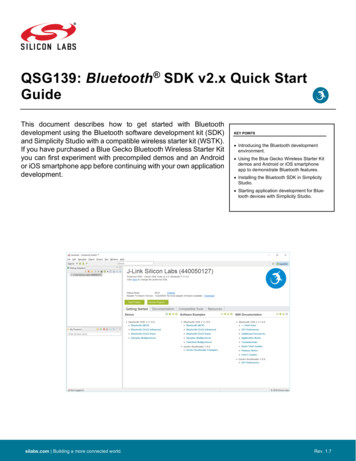
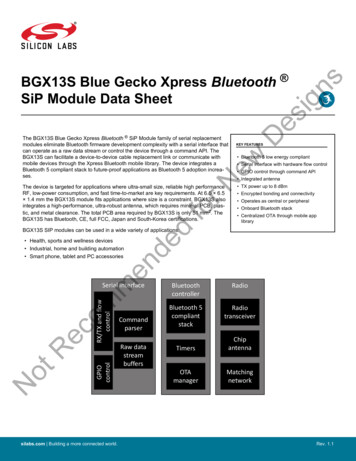
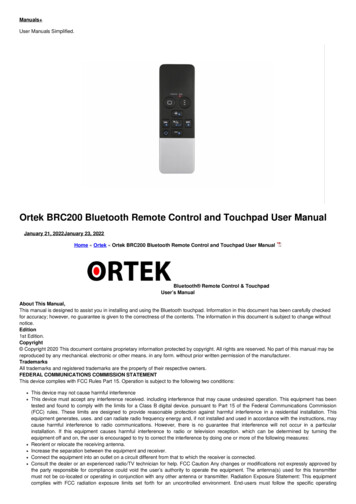

![[MS-CDP-Diff]: Connected Devices Platform Protocol Version 3](/img/35/5bms-cdp-5d-220429-diff.jpg)

